市场营销学通论(第三版)
- 格式:ppt
- 大小:1.28 MB
- 文档页数:18
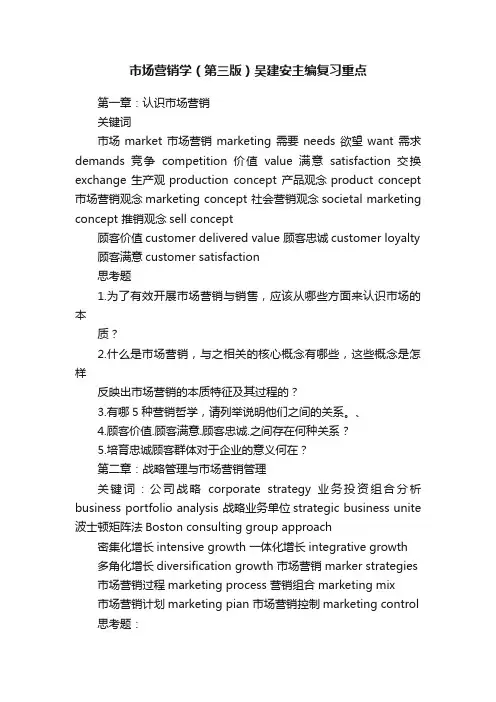
市场营销学(第三版)吴建安主编复习重点第一章:认识市场营销关键词市场market 市场营销marketing 需要needs 欲望want 需求demands 竞争competition 价值value 满意satisfaction 交换exchange 生产观production concept 产品观念product concept 市场营销观念marketing concept 社会营销观念societal marketing concept 推销观念sell concept顾客价值customer delivered value 顾客忠诚customer loyalty 顾客满意customer satisfaction思考题1.为了有效开展市场营销与销售,应该从哪些方面来认识市场的本质?2.什么是市场营销,与之相关的核心概念有哪些,这些概念是怎样反映出市场营销的本质特征及其过程的?3.有哪5种营销哲学,请列举说明他们之间的关系。
、4.顾客价值.顾客满意.顾客忠诚.之间存在何种关系?5.培育忠诚顾客群体对于企业的意义何在?第二章:战略管理与市场营销管理关键词:公司战略corporate strategy 业务投资组合分析business portfolio analysis 战略业务单位strategic business unite 波士顿矩阵法Boston consulting group approach密集化增长intensive growth 一体化增长integrative growth多角化增长diversification growth 市场营销marker strategies 市场营销过程marketing process 营销组合marketing mix市场营销计划marketing pian 市场营销控制marketing control 思考题:1.分析企业总体战略和营销战略之间的关系。

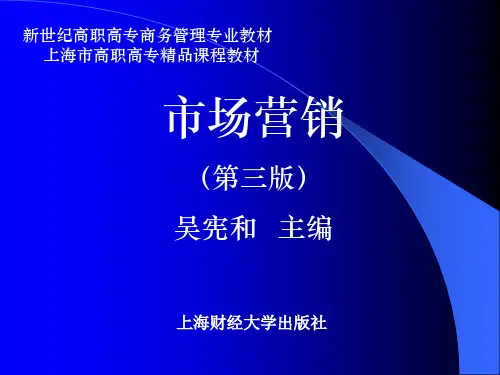
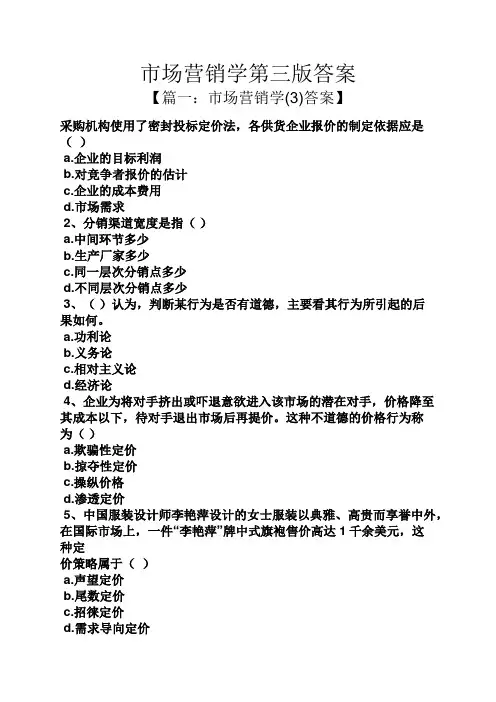
市场营销学第三版答案【篇一:市场营销学(3)答案】采购机构使用了密封投标定价法,各供货企业报价的制定依据应是()a.企业的目标利润b.对竞争者报价的估计c.企业的成本费用d.市场需求2、分销渠道宽度是指()a.中间环节多少b.生产厂家多少c.同一层次分销点多少d.不同层次分销点多少3、()认为,判断某行为是否有道德,主要看其行为所引起的后果如何。
a.功利论b.义务论c.相对主义论d.经济论4、企业为将对手挤出或吓退意欲进入该市场的潜在对手,价格降至其成本以下,待对手退出市场后再提价。
这种不道德的价格行为称为()a.欺骗性定价b.掠夺性定价c.操纵价格d.渗透定价5、中国服装设计师李艳萍设计的女士服装以典雅、高贵而享誉中外,在国际市场上,一件“李艳萍”牌中式旗袍售价高达1千余美元,这种定价策略属于()a.声望定价b.尾数定价c.招徕定价d.需求导向定价6、在赊销的情况下,卖方为了鼓励买方提前付款,按原价给予一定的折扣,这就是()。
a.功能折扣b.现金折扣c.季节折扣d.数量折扣7、某企业欲运用需求价格弹性理论,通过降低产品价格提高其销售量,一般情况下,这种策略对下列(a.产品需求缺乏弹性b.产品需求富有弹性c.生活必需品d.名牌产品8、认知价值定价法运用的关键是()a.确定适当的目标利润b.准确了解竞争者的价格c.正确计算产品的单位成本d.确定顾客对产品的认知水平9、销售分析、市场占有率分析、财务分析、顾客满意度追踪等是()常用的方法。
)类产品效果明显。
a.年度计划控制b.盈利能力控制c.效率控制d.战略控制10、制造商推销价格昂贵、技术复杂的机器设备时,适宜采取()的方式。
a.广告宣传b.营业推广c.经销商商品陈列d.人员推销11、电话局在一天中对电话费按不同的标准收费,这种定价策略叫()a.认知价值定价法b.区分需求定价法c.心理定价策略d.习惯定价法12、制造商尽可能多地通过许多负责任的适当的批发商、零售商推销其产品,这种渠道策略称为(a.密集分销b.选择分销c.独家分销d.间接分销13、当产品处在生命周期的成熟期时,应采用()a.通知广告)b.劝说广告c.提示广告d.报纸广告14、有些制造商通过不同渠道将同一产品送到不同的市场,这种渠道系统属于()a.垂直渠道系统b.传统渠道系统c.水平渠道系统d.多渠道系统15、“三元”公司为使广大消费者能随时随地买到“三元”牛奶这种日常用品,通常采用的渠道策略是()a.密集分销b.选择分销c.独家分销d.间接分销16、当市场有足够的购买者,它们的需求缺乏弹性时,应使用()a.折扣定价b.撇脂定价c.渗透定价d.尾数定价17、不同层次的独立的制造商和中间商以合同为基础建立的联合渠道系统,以求获得比其独立行动时所能得到的更大的经济和销售效果。
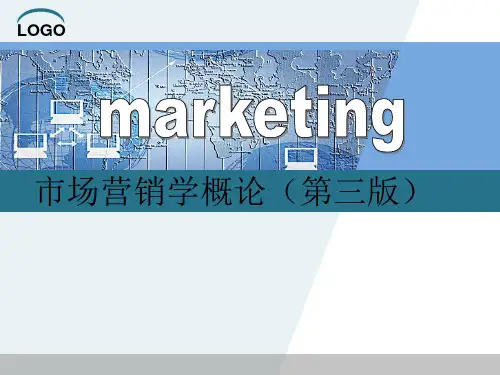
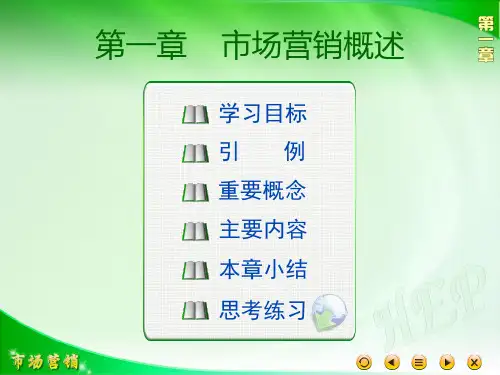
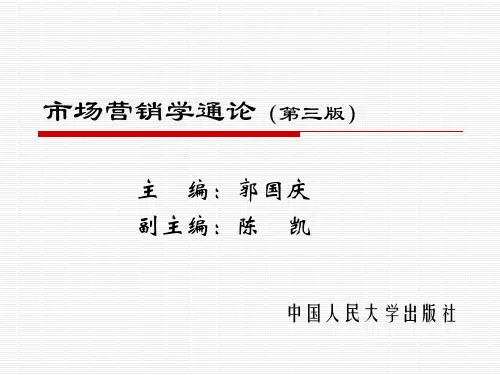
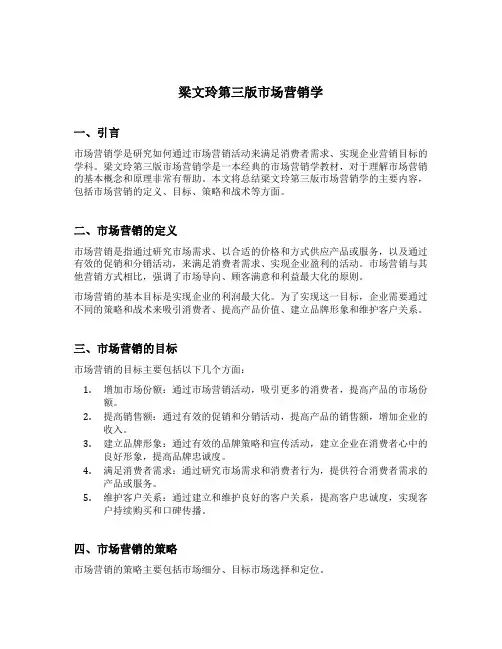
梁文玲第三版市场营销学一、引言市场营销学是研究如何通过市场营销活动来满足消费者需求、实现企业营销目标的学科。
梁文玲第三版市场营销学是一本经典的市场营销学教材,对于理解市场营销的基本概念和原理非常有帮助。
本文将总结梁文玲第三版市场营销学的主要内容,包括市场营销的定义、目标、策略和战术等方面。
二、市场营销的定义市场营销是指通过研究市场需求、以合适的价格和方式供应产品或服务,以及通过有效的促销和分销活动,来满足消费者需求、实现企业盈利的活动。
市场营销与其他营销方式相比,强调了市场导向、顾客满意和利益最大化的原则。
市场营销的基本目标是实现企业的利润最大化。
为了实现这一目标,企业需要通过不同的策略和战术来吸引消费者、提高产品价值、建立品牌形象和维护客户关系。
三、市场营销的目标市场营销的目标主要包括以下几个方面:1.增加市场份额:通过市场营销活动,吸引更多的消费者,提高产品的市场份额。
2.提高销售额:通过有效的促销和分销活动,提高产品的销售额,增加企业的收入。
3.建立品牌形象:通过有效的品牌策略和宣传活动,建立企业在消费者心中的良好形象,提高品牌忠诚度。
4.满足消费者需求:通过研究市场需求和消费者行为,提供符合消费者需求的产品或服务。
5.维护客户关系:通过建立和维护良好的客户关系,提高客户忠诚度,实现客户持续购买和口碑传播。
四、市场营销的策略市场营销的策略主要包括市场细分、目标市场选择和定位。
1.市场细分:市场细分是将整个市场细分为若干个具有明显差异的消费者群体。
通过市场细分,企业可以更好地理解不同消费者群体的需求和行为,并针对不同群体制定相应的营销策略。
2.目标市场选择:在市场细分的基础上,企业需要选择最有潜力和最适合自己的目标市场。
目标市场选择需要考虑市场规模、竞争程度、消费者需求等因素。
3.定位:定位是通过市场调研和市场定位分析,确定产品在目标市场中的定位点。
定位可以通过产品特点、价格、品牌形象等方面来实现。
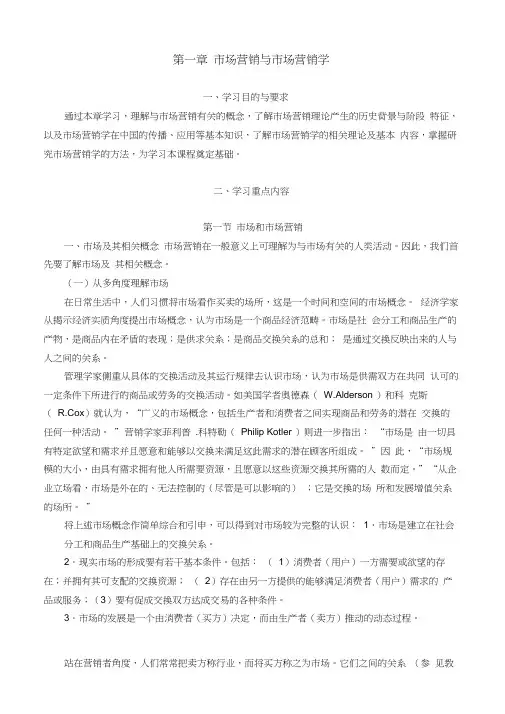
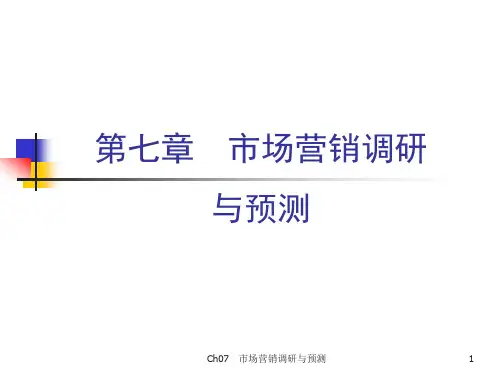
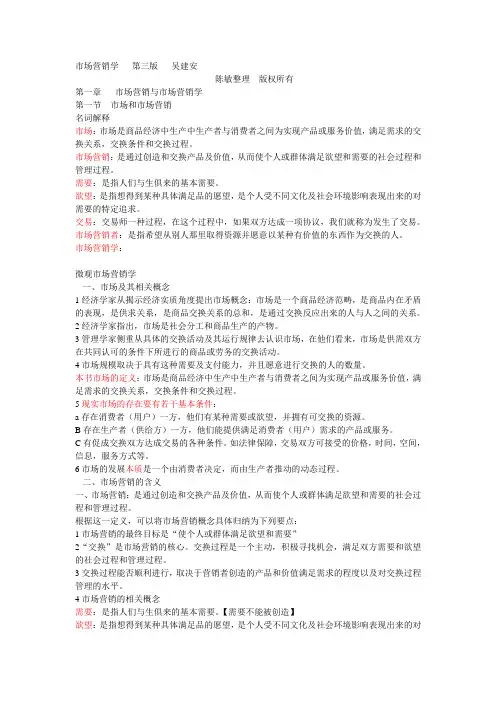
市场营销学第三版吴建安陈敏整理版权所有第一章市场营销与市场营销学第一节市场和市场营销名词解释市场:市场是商品经济中生产中生产者与消费者之间为实现产品或服务价值,满足需求的交换关系,交换条件和交换过程。
市场营销:是通过创造和交换产品及价值,从而使个人或群体满足欲望和需要的社会过程和管理过程。
需要:是指人们与生俱来的基本需要。
欲望:是指想得到某种具体满足品的愿望,是个人受不同文化及社会环境影响表现出来的对需要的特定追求。
交易:交易师一种过程,在这个过程中,如果双方达成一项协议,我们就称为发生了交易。
市场营销者:是指希望从别人那里取得资源并愿意以某种有价值的东西作为交换的人。
市场营销学:微观市场营销学一、市场及其相关概念1经济学家从揭示经济实质角度提出市场概念:市场是一个商品经济范畴,是商品内在矛盾的表现,是供求关系,是商品交换关系的总和,是通过交换反应出来的人与人之间的关系。
2经济学家指出,市场是社会分工和商品生产的产物。
3管理学家侧重从具体的交换活动及其运行规律去认识市场,在他们看来,市场是供需双方在共同认可的条件下所进行的商品或劳务的交换活动。
4市场规模取决于具有这种需要及支付能力,并且愿意进行交换的人的数量。
本书市场的定义:市场是商品经济中生产中生产者与消费者之间为实现产品或服务价值,满足需求的交换关系,交换条件和交换过程。
5现实市场的存在要有若干基本条件:a存在消费者(用户)一方,他们有某种需要或欲望,并拥有可交换的资源。
B存在生产者(供给方)一方,他们能提供满足消费者(用户)需求的产品或服务。
C有促成交换双方达成交易的各种条件。
如法律保障,交易双方可接受的价格,时间,空间,信息,服务方式等。
6市场的发展本质是一个由消费者决定,而由生产者推动的动态过程。
二、市场营销的含义一、市场营销:是通过创造和交换产品及价值,从而使个人或群体满足欲望和需要的社会过程和管理过程。
根据这一定义,可以将市场营销概念具体归纳为下列要点:1市场营销的最终目标是“使个人或群体满足欲望和需要”2“交换”是市场营销的核心。
梁文玲第三版市场营销学的资料梁文玲第三版市场营销学是市场营销学领域的重要著作之一,其内容全面系统,涉及众多营销学理论和实践案例,深受广大营销从业者和学生们的喜爱和推崇。
下面,我们就来分步骤阐述一下这部著作的特点和价值。
第一步,综观全书。
梁文玲第三版市场营销学包含三个部分,分别是基础知识、营销策略和实践应用。
其中基础知识主要介绍了市场营销学的基本理论、营销环境分析、消费者行为等;营销策略重点讲解了市场定位、产品策略、价格策略、渠道策略和推广策略等;实践应用部分则结合了大量实践案例,详细介绍了如何开展市场调研、制定营销计划和进行市场推广等。
全书结构严谨,内容翔实,涵盖面广,既适合营销专业学生的学习,也可以为营销从业者提供实用的指导。
第二步,深入剖析理论体系。
梁文玲第三版市场营销学围绕市场、产品、价格、渠道和推广五大要素搭建了一个清晰、完整的理论体系。
其中,针对市场要素,书中详细介绍了市场的基本属性、市场细分、市场定位等相关知识;针对产品要素,对产品开发、产品定位、产品组合等进行了深入解析;针对价格要素,论述了价格定位、价格战略、市场价格体系等;针对渠道要素,探讨了渠道设计、渠道选择和渠道管理等;针对推广要素,详细介绍了广告、促销、公关、个人销售等推广手段。
这些理论知识体系清晰、层次分明、科学完整,能够有效帮助营销专业学生建立起正确的市场营销思维方式。
第三步,剖析实践案例。
梁文玲第三版市场营销学涵盖了大量的营销实践案例,这些案例涵盖了各种不同类型的产品和服务,从传统的实体产品到互联网服务,从消费类市场到B2B市场,使人们可以对营销理论与实践之间的联系有更深刻的理解。
同时,每个案例都有详细的分析和评价,以及市场营销策略制定、实施和效果分析的全过程,方便读者更好地理解和应用营销理论。
这些案例也为企业的营销管理提供了宝贵的经验借鉴。
总之,梁文玲第三版市场营销学作为市场营销学领域的重要著作,内容丰富、理论完整、应用广泛,是一本十分优秀的市场营销学教材,既适合市场营销专业学生的学习,也可以为营销从业者提供实用的指导。
Yuma Puma: Stock ShockCase OverviewAfter a successful home market launch, Yuma Puma decided to enter the global marketplace and enter an initial foreign market. We did so successfully. In fact, we were too successful. Demand exceeded our ability to produce and deliver our product. We had to retrench and leave that market. Our exit caused anger and frustration with both channel partners (our retailers and distributors) and ultimate consumers. Now, six months later, we believe we have corrected the problems, expanded production capacity, and are ready to re-enter that market. But, we’ve got to regain the trust and confidence of retailers and distributors as well as consumers. Remember, our product was well-received. We just were unable to fulfill our promises. Will both our channel partners and ultimate consumers give us a second chance?This case can be effectively used to focus a discussion on the following topics: •Retailing•Channels•Global Marketing•Buyer Information Search•Market Entry Strategies•Product/Promotion Planning•Relationship MarketingSummary of Stand-In PositionsSequential Presentation of CaseStep One: PlanMarketing ProblemAfter our initial launch, we moved into our second market and excitingly experienced a consumer response far beyond our projections. But, after eight months we ran out of stock and were unable to deliver to all of our retail outlets (both traditional and untraditional). It is taking six months to overhaul the local manufacturing and delivery system and get product back on the shelves.•How could Yuma Puma ensure its manufacturing plan is better on target and more flexible to rebound from future fluctuations in demand?•How could Yuma Puma appease unhappy retailers?•Should Yuma Puma prioritize its unhappy retailers and bring different solutions to appease larger and/or smaller retailers?•How could Yuma Puma win over disgruntled consumers?•How could Yuma Puma re-establish its image?Data Review – Company DocumentsThe case presentation in Marketer’s Showdown includes five different company documents. A brief overview of these five documents is provided below.1.Customer Feedback Letter from Venezuelan Consumera.We had a successful short-term introductionb.We built consumer demandc.We began to build a bond with consumersd.Then, we left the Venezuelan market2.Sellout Report (sales prior to market exit)a.Sales increases over 8-month market availability periodb.Huge increases in Health Clubs, Bars/Clubs, and Social Eventsmunications Summary from Venezuelan Distributorsa.Dichotomy of responses.b.Often, one-half to two-thirds of customer communications expressdissatisfaction with the lack of availability of our product4.Yuma Puma Company Overviewa.Venezuelan/Thai carbonated energy drinkb. 2 billions cans sold in over 120 countries in most recent yearc.Cool brandunched in 1989 in South Americae.Sponsorship of extreme sports and race carf.Mobile units build awareness and excitement for brandg.New imitators have since entered the market5.Yuma Puma 3-Step Guerrilla Marketinga.Establish word-of-mouth communicationb.Achieve street visibilityc.Build a presence on university campusesData Review – Marketing Concept DocumentsThe case presentation in Marketer’s Showdown includes three marketing concept documents. A brief overview of these three documents is provided below.1.Consumer Information from Magazinesa.50% of consumers get information about food from magazinesb.Extreme sports are likely for our consumersi.49% get information about sports equipment from magazinesand 24% from televisionii.49% get information about fitness / exercise from magazinesand 36% from television2.Product/Promotion Matrix (3x2)a.Same Product / Same Promotion = Product Extension Strategyb.Same Product / Adapt Promotion = Communication AdaptationStrategyc.Adapt Product / Same Promotion = Product Adaptation Strategyd.Adapt Product / Adapt Promotion = Dual Adaptation Strategye.Create New Product (regardless of promotion) = Product InventionStrategy3.Satisfying Customers to Build Profitable Relationshipa.Providing value leads to satisfied customerb.Satisfied customers are more likely to be retainedc.Retaining customers leads to profitable mutually-beneficialrelationshipsd.Firm must commit to this circular fulfillmentStrategy GeneratorStudents are asked to answer six questions regarding their initial responses or reactions to the case material presented to this point. Students are acting largely on the content presented in three places: (1) Marketing Problem Internal Memo, (2) the five company documents, and (3) the three marketing concept documents. Student responses to these six questions will suggest a Stand-In character to represent their point of view.The specific questions for “Stock Shock” are presented below.1.The campaign focus should be:a.Strengthen brandb.Strengthen channelc.Fulfill demand2.The tone of the marketing response should be:a.Honest and apologeticb.Business as usualc.Reassuring3.The goal of the plan should be to:a.Regain retail supportb.Regain customer loyaltyc.Increase sales4.The audience focus should be on:a.New customersb.Customers and retailersc.Retailers only5.The approach should utilize:a.Promotionsb.Promotions and advertisingc.Standard mix6.The response scale should be:a.Minimalb.Selectivec.Full-scaleNext, students are asked to elaborate on their responses to these six questions. The elaborations can be saved, printed, or emailed. For this case, the elaboration questions are:1.Why is the campaign focus to ?2.Why is a tone approach?3. is the most important goal because:4.Why are the key players to focus on?5.How did you choose to utilize a approach?6.Why is the appropriate scale?Step Two: DebateStand-In SelectorMarketer’s Showdown takes the student’s responses to the above six questions (not including their short essay elaborations) and matches them with one of three Stand-In characters in the case. Students then watch their chosen advocate explain their recommended strategy to see if they agree with the position advocated. They can also watch the other two positions (and advocates) to see if they are more supportive of these alternative positions. The three Stand-In characters and their positions are profiled below.Emily’s position – My strategy is to not expressly address our having left themarket and seeking now to return. Yes, we had a lack of stock for six months.But, we should not draw any more attention to this matter. The brand has aloyal following. We provide retailers with a high profit margin to resell ourproduct. They will welcome us back. We got too big too fast. We were verysuccessful during our 8-month market presence. There is no need to re-introduce our product to consumers and retailers. We must simply reassureretailers we are back to stay. We will be welcomed back given the strength of our brand.Eric’s position – We must acknowledge we made mistakes in the past. Weunderestimated the demand for our product. We over-estimated our ability toserve this demand. We got caught short. We cannot change the past. Wemove forward. We did demonstrate the interest in our brand. Promotions toboth consumers and retailers will be needed to support the re-introduction ofour product back into the market. Expressed acknowledgement of our pastfailures will increase the stature of the brand and demonstrate our authenticityas a company.Greg’s position – We must reassure our distributors that we have correctedthe problems from our earlier introduction and we return committed to themarket. That said, we do not need to spend extra time and money reassuringthe end consumer about our long-term commitment to the market (i.e., that we are here to stay). Simply getting the product back onto the shelves will servethe needs of end users. Our focus should be on assuring distributors andretailers (and not end consumers) about our commitment to the market. Students must select one of the three Stand-In characters and their recommended strategy for the company moving forward.Marketer MeetingStudents watch the Marketer Meeting while being prompted periodically to answer specific questions regarding the flow of the discussion. Based on the selection of Stand-In character, questions specific to that Stand-In character are presented on the screen for students to address.Stand-In EvaluatorThe student’s responses to the six questions posed during the Marketer Meeting are presented on the screen along with an evaluation of that Stand-In character’s performance provided by Marketer’s Showdown. Next, the students can evaluatehow well they believe their chosen advocate (i.e., their Stand-In character) presented their recommended strategy during the Marketer Meeting. This is done by answering these six elaboration questions. An example question is, “Was this the best approach? Explain why or why not.” These elaborations can be saved, printed, or emailed.Step Three: ExecuteStand-In Selector IIEach of the three Stand-In characters (Emily, Eric, and Greg) then recaps his/her position one final time. And, they reflect on how well they believe they presented their position in the Marketer Meeting. Here, the student is given one final opportunity to select their desired Stand-In character having seen how each position was received relative to the other two proposed strategies. They can stay with their original choice or switch to one of the other two alternatives. Once this selection is made, the student will not be able to switch positions. This strategy will then be implemented in Marketer’s Showdown.Outcome PredictorA final summary of the position of the designated Stand-In character is presented on-screen along with six questions:1.The new campaign revolves around:a.Brandingb.Retail channelc.Product demand2.The primary action is:a.Gain retail loyaltyb.Resume marketingc.Apologize3.The secondary action is:a.Expand audienceb.Retail incentivesc.Widespread campaign4.The short-term outcome will be:a.Regain reputationb.Strengthen retail channelc.Resume sales levels5.The long-term outcome will be:a.Market share leaderb.Broaden basec.Residual fallout6.The next challenge will be:a.Growing presenceb.Regaining reputationc.Expanding channelStudents respond to these six questions as they seek to predict the impact of implementing their chosen strategy as advocated by their Stand-In character. Outcome NewsbriefThe student’s answers to the six questions presented immediately above are presented on the right-side of the screen. On the left-side of the screen, the Outcome Newsbrief presents the ultimate resolution to the case. NOTE: The resolution of the case is driven by the student’s answers. That is, the choice of Emily, Eric, or Greg as a Stand-In character leads to the enactment of that specific strategy. The implementation of this strategy then drives the case toward the resolution presented. There were three possible strategies to choose from in this case. In a typical class, each of these three options likely has some support among your students. To help you compare the three strategies available, the table below presents how each strategy would address the six questions presented in the Outcome Predictor module.The Results of Implementing Each Suggested StrategyThis case addressed a central question. Three different strategies/solutions were presented. In the table below, the results of implementing all three strategies are presented. Your students will likely want to know the results of implementing the strategies they did not select. This table helps you answer these questions. Consistently in Marketer’s Showdown, there is no defin itive solution. Rather, an ever-changing marketplace presents a variety of appropriate responses at any given point in time.Final EvaluatorIn the Final Evaluator section, the student’s answers are presented along with the recommended answers in the Marketer’s Showdown. Students are asked a series of four essay questions:1.Did the outcome meet your expectations?2.Pinpoint where in the process things went off-track or excelled?3.What are the new Marketing goals?4.What strategy would you implement now?Student responses may be saved, printed, and/or emailed.Suggested Teaching TipsHere are some concepts and examples you may find helpful to integrate into your class discussion of “Stock Shock.”Planning for growth– Yuma Puma built a business in a foreign market but was unable to expand its manufacturing and distribution capacity quickly enough to satisfy this demand. Consequently, they left the marketplace. They now seek to return. You must plan for growth. You must manage growth.Investing to build manufacturing and distribution capacity and the need to realize a return on that investment– Yuma Puma needs to rebuild its demand in the new market to recoup the investment needed to expand capacity. You invested resources and now must generate cash flow to cover this cost.Earning the confidence of your channel partners– channel partners are a bit wary of Yuma Puma’s re-entry. They must be won over.Keeping the confidence of your channel partners– channel relationships must be cultivated. Strong relationships don’t always happen by chance. It t akes work.Keeping brand loyal consumers brand loyal– Yuma Puma built a brand following and walked away. Consumers may or may not come back to our brand assuming we re-enter that market.Word-of-mouth communication (and varying levels of feedback for both positive and negative performance)– buyers will tell more people of their dissatisfaction than times when we achieve satisfaction.Brand personality–we’re a cool brand. Methods and media should work to reinforce this desired position. IMC suggests a consistent theme to reinforce desired position. Impact of stock-out’s– out-of-stock merchandise can cause lost sales in the current period. Buyers may opt not to buy or even brand-switch. And, frequent stock-out’s may prompt buyers to switch to other brands or even resellers.Combining Push and Pull promotion– Push promotion is meant to encourage channel partners to support our product. Pull promotion is meant to stimulate consumers to actively seek our product in the marketplace. We typically c ombine these two efforts … motivated buyers and motivated resellers.Should we publicly acknowledge company failures? – Does apologizing for a past mistake (such as our market exit) earn consumer trust or remind them of past failings? Good question.Suggested Objective Questions for Exams and/or Quizzes Assessing Student Readiness QuestionsWhich statement below best captures the essence of this case?A.With a sagging stock price, we must consider new products to enhancerevenues and profitability.B.We are considering a major shift away from smaller retailers to massmerchants.C.We entered a market and were well-received by consumers. But, supplyproblems caused mass product shortages. These supply problems havebeen fixed and we wish to recommit to this market.What is the purpose of the Yuma Puma trucks?A.Service our accountsB.Attract attention and distribute complimentary productsC.Sign up consumers for the Yuma Puma credit cardWhich is the best description of our core Yuma Puma buyer?A.Generation YB.Baby BoomersC.Pre-WWII/Greatest GenerationAs presented in the case, which media is most often turned to by consumers seeking knowledge, information, and usable ideas?A.RadioB.TelevisionC.NewspapersD.MagazinesHistorically, word-of-mouth communication has had a limited role in the marketing of Yuma Puma.A.TrueB.FalseApplication and/or Integrative QuestionsWhich statement about word-of-mouth communication is most accurate?A.You are more likely to tell others of your satisfaction than your dissatisfaction.B.You are equally likely to tell others about your satisfaction and dissatisfaction.C.You are more likely to tell others about your dissatisfaction than yoursatisfaction.PUSH promotional efforts focus on the ultimate consumer while PULL promotional efforts focus on members of the channel of distribution.A.TrueB.FalseIt is less expensive for an organization to retain existing consumers and more fully penetrate their purchasing capacity than to replace that demand with new consumers.A.TrueB.FalseLet’s assu me Yuma Puma chooses a market entry strategy of selling their existing product (Yuma Puma) supported by their existing promotional programs used in other markets. This would represent which strategy profiled in the Product-Promotion Matrix?A.Product Extension StrategyB.Product Adaptation Strategymunication Adaptation StrategyD.Dual Adaptation StrategyE.Product Invention StrategyLet’s assume Yuma Puma implements a market entry strategy of changing their product but using existing promotional programs used in other markets to support the rollout. This would represent which strategy profiled in the Product-Promotion Matrix?A.Product Extension StrategyB.Product Adaptation Strategymunication Adaptation StrategyD.Dual Adaptation StrategyE.Product Invention StrategyLet’s assume Yuma Puma chooses a market entry strategy of selling their existing product (Yuma Puma) but elects to change their promotional program to meet the unique needs of that marketplace. This would represent which strategy profiled in the Product-Promotion Matrix?A.Product Extension StrategyB.Product Adaptation Strategymunication Adaptation StrategyD.Dual Adaptation StrategyE.Product Invention StrategyThe operating philosophy focused on providing value, satisfying customers and retaining these satisfied customers over time is known as:A.Transactional MarketingB.Relationship MarketingC.Guerrilla MarketingYuma Puma’s decision to enter a foreign market following success in their home market illustrates which growth strategy from the Product-Market Growth Matrix?A.Market PenetrationB.Market DevelopmentC.Product DevelopmentD.DiversificationYuma Puma uses which type of marketing channel configuration?A.Virtual channel of distributionB.Direct channel of distributionC.Indirect channel of distributionPoint-of-purchase displays, free cases of product, promotional allowances, and special promotional pricing are suggested as ways of supporting a market re-entry. These promotional measures are associated with promotion.A.PushB.PullC.AdaptiveSuggested Discussion QuestionsWhat are the short-term and long-term costs of stock-outs for a company? Be sure to address both end consumers and channel partners in your response.A shopper looking for something on the shelves and unable to find it has a fewchoices, including:•Forgoing the purchase if it is not absolutely essential to have at thatmoment (e.g., I need peanut butter but there is some left in the jar).•Staying brand loyal but visiting another store to find the item.•Selecting a new brand in that store.•Selecting a new brand in another store.So, in the short-term, the manufacturer (as well as the retailer) faces lost sales, the possibility of lost buyer loyalty, and eroding consumer confidence that they willfind the brands they prefer. In the long-run, these brand-switching consumersmay never come back, these shoppers may frequent stores with a perceived lower likelihood of stock-outs, and the further eroding confidence may make it evenmore difficult to reach them.How could Yuma Puma apply the Product/Promotion matrix included in the case?Product Extension Strategy (Existing Product, Existing Promotion)– Re-enter the market selling Yuma Puma supported by the existing guerrilla marketing tactics. This includes event sponsorship, Yuma Puma vehicles, extreme sportssponsorship, nontraditional media, and other opportunities to connect directlywith consumers.Product Adaptation Strategy – (Adapted Product, Existing Promotion)–Research may have indicated the original product, brand, or packagingformulation may require change but the promotional program will likely be well-received. For instance, Coca Cola has markets such as Japan and Germany where the brand Diet Coke is sold as Coke Lite. Domino’s Pizza offers Seafood Special Pizza (with squid and shrimp) in Japan, Crème Fresch Pizza in France, and Tunaand Sweet Corn Pizza in England. Other aspects of the marketing programremain somewhat standardized.Communication Adaptation Strategy (Existing Product, Adapted Promotion)– Research may have indicated that consumers would show a preference for theoriginal product but the creative promotions may be poorly received. So, forexample, Yuma Puma’s irreverent promotional tactics may not be understood oreven accepted. Extreme sports may not be a part of the youth culture, thusrequiring adaptation of the promotional program. Different positions in differentmarkets are also possible. Corona beer is an inexpensive beverage in Mexico but perceived as a premium product by many U.S. consumers.Dual Adaptation Strategy (Adapted Product, Adapted Promotion)– Research may have indicated the original product, brand, or packaging formulation mayrequire change as well as the promotional program. So, Yuma Puma may need to adapt its product as well as its promotional program.Product Invention Strategy (New Products with both existing and newpromotional appeals)– Yuma Puma produces an energy drink. As discuss inanother case (Yuma Puma: Category Crowd Control), the firm may consider other ways of delivering energy to consumers, including energy water, pills, candies,and other forms.Propose both a PUSH and PULL promotional strategy to guide Yuma Puma during market re-entry.PUSH promotional strategies focus on members of the channel of distribution toencourage them to stock the product for resale. Common PUSH promotionsYuma Puma may consider include:•Advertising to channel members•Point-of-purchase displays•Price deals•Promotional allowances•Cooperative advertising•Sales contests•Calendars•Gifts or Premiums•Merchandising aidsPULL promotional strategies focus on building demand among ultimateconsumers thus encouraging them to actively seek the product from retailers orwholesalers. Common PULL promotions Yuma Puma may consider include: •Advertising to consumers•Sales Promotions•Coupons•Sweepstakes•Trial Sizes•Gifts or Premiums•Event sponsorshipDiscuss how digital media is changing the communication landscape with respect to magazine, radio, television, and newspapers. Be sure to discuss your students’current media habits as they would be a target consumer for messages from Yuma Puma.Ask your students the following questions:•How many read at least one magazine regularly? How has thischanged over the last few years?•How many read a newspaper regularly? How has this changed over the last few years?•How many listen to a radio regularly? How has this changed over the last few years?•Are you watching more or less television than in prior years? And, in what form (such as DVD, on-demand, DVR format)?Magazines provide a very selective audience but your students are likely reading more online media. They may not even look at a newspaper, but they may look ata newspaper website. This is particularly true of out-of-town or out-of-statestudents monitoring their home-town media for a distance. They control theprogramming on their iPods as well as television. Media usage patterns havechanged. Organizations seeking to use these media to communicate withconsumers must respond.Discuss the implications for marketers trying to reach the demographic of YumaPuma … your students.One Stand-In character suggests we should not active spend money and time re-earning the confidence of our channel partners. She suggests we re-enter the market and the popularity of our product will be enough. We should not apologize or even acknowledge our past shortcomings. What do you think?Some argue that apologizing ‘legitimizes’ or reminds people of our past failings.They would argu e why bring up old business from the past. Rather, let’s looktoward a bright future. Others argue that we cannot simply ‘wish away’ our past failings. We should deal with them up front and directly, apologize, and worktoward that bright future.Some salespeople take a similar approach to their competition. Yes, we knowthey are competitors. But, they believe the more you talk about your competition, the greater credibility you give them in the mind of your consumer.One Stand-In character suggests we reward consumers who register via email by giving them a free Yuma Puma tee shirt. What is the firm’s true motivation here? And, tell us the kinds of firms you’ve registered with an d how they communicate with you as a result of you’re opting in. And, what about your text message opt-ins as well?Consumers registering on the firm’s website makes possible a very targetedmarketing effort. Ask your students to share the types of marketing messagesthey typically receive via emails. How did these firms get their email accounts?Are they effective?The use of text messaging by marketers is expected to continue to grow. Textusers opt into a relationship with an organization when they text to a location ornumber to enter a contest. These consumers can now expect to receive notice ofspecials, new product introductions, and other marketing text messages. And, the research indicates these consumers are more likely to read these messages thanthose included in traditional broadcast media. The Obama Presidential Campaign of 2007-2008 was able to use text messaging effectively to share appeals withvoters while sending reminders to vote or to encourage friends to vote. Youngvoters participated in higher numbers than recent years. Text messaging may beone reason.Yuma Puma has an active on-campus marketing effort. Here is some text from the case taken from one of the company documents (#5):“The company also set about promoting the Yuma Puma brand directly toGeneration Y, who are believed to be cynical of traditional marketing strategies.Part of this idea involved recruiting students who would promote Yuma Pumaon university campuses. These students would be encouraged to throw parties at which free cases of Yuma Puma would be distributed.”Discuss what firms your students believe have both similarly active and effective on-campus marketing efforts.The results of this question may surprise you. As an instructor, you are likelyolder than your students and not part of the demographic to which they belong.So, you don’t see a lot of the marketing messages targeting them. Example firms that maintain college programs include: Red Bull, Playboy, Sports Illustrated,Disney, Apple, Ben & Jerry’s, Sprint PCS, Sony Music, and others.。